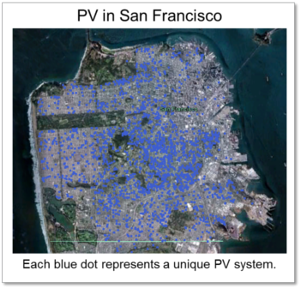Over the past few weeks, we’ve plotted out emerging solar industry trends for the upcoming year, including solar soft cost reductions, and a re-examination of net metering. These first two topics are primarily about the financials of PV: reducing system costs and determining fair compensation for power produced by distributed PV.
The third trend is being driven by another factor: high numbers of PV systems integrated into the grid. As the penetration of PV increases, the way in which utilities and grid operators, including Independent System Operators (ISOs) and Regional Transmission Organizations (RTOs), plan and operate their electrical distribution systems is fundamentally changing.
California is a prime example of high-penetration PV. As of the end of 2012, California’s PV capacity of more than 2.5 GW exceeded the size of the Diablo Canyon Nuclear Power Plant. This PV capacity is a mix of large utility-scale PV plants directly connected to the grid, and distributed PV generation located ‘behind-the-meter’ at customers’ homes and businesses.

With high penetration PV, utilities and ISOs are challenged with finding ways to integrate PV into the grid reliably, safely and cost-effectively. To understand the challenge, let’s examine four ways in which PV generation has the potential to impact grid reliability.
- Distribution system voltage. We all rely on utilities to deliver electricity with a consistent voltage. If you’ve ever experienced flickering lights or a full-blown brown-out, you know how important this is. The addition of PV to an electric distribution line makes this more difficult, as PV, by nature, is a variable energy source. With PV, line voltage fluctuations can occur during partially cloudy periods due to rapid changes in PV power output. When systems are spread across a large geographic range, it can help smooth this effect across a distribution area, as not all PV systems will be impacted by cloud cover at the same time. However, when there is a concentration of PV systems in close proximity, the potential for such voltage fluctuations increases. In this environment, voltage regulation devices have to operate more frequently and can wear out faster than expected.
- Load scheduling. Electricity is a commodity that is bought and sold by utilities, based on forecasted demand at any given moment, in any given location. As such, accurate forecasting is important to keeping the cost of electricity low, as inaccurate forecasts may result in higher wholesale market costs (in the case of an ISO) or higher internal operating costs (in the case of self-scheduling utilities). When PV represents a significant component of the generation mix, it must be taken into consideration when forecasting loads. Generating units cannot be efficiently dispatched without accurate load and PV power forecasts for both utility-scale solar plants, and distributed PV generation from residential and commercial systems.
- Frequency regulation. Grid operators are tasked with regulating frequency by matching electricity generation to load in real time. Rapid changes in load due to PV power fluctuations could complicate this by requiring more load-following capacity – capacity from generation plants that can rapidly ramp electricity production up or down – during periods of high power variability. This is of particular concern in balancing areas that cover smaller geographic regions.
- Resource planning. Daily utility load profiles – the total amount of electricity needed to meet demand at any point in time throughout the day – will change with higher levels of PV penetration. Because PV generates electricity during daylight hours, generation needs during the day will be reduced, and peaks will be shifted. This could result in an increase in ramp rates during certain times of the day, requiring the use of more expensive, faster-responding generating technologies.
Utilities, ISOs and government energy agencies have begun investing in solutions to accurately forecast variability of behind-the-meter PV, and address the challenges described above. This capability is critical for planning and operations, and will make it possible to integrate PV reliably and cost-effectively.
At the High-Penetration PV Forum held last week in San Diego by the Department of Energy’s SunShot Initiative and California Public Utilities Commission (CPUC), researchers presented a number of approaches to solving these problems. Utilities are eager to see scaled-up demonstrations that will validate these technologies as viable solutions. It seems clear that the next phase of product development will involve demonstration projects combining universities, private research companies and utilities.
Clean Power Research also participated in the event, presenting recent advancements in forecasting the variability of fleets of PV systems. Look for more insight into this work in the coming weeks.
